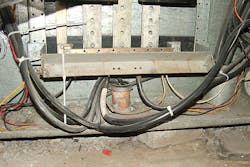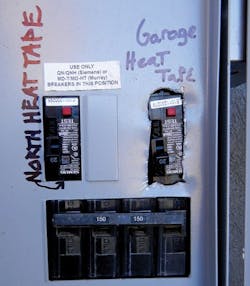"Holey" Hacker
Section 110.3(B) has been violated because equipment must be installed in accordance with the listing or labeling instructions. I strongly doubt we would ever find instructions on how to hack open the cover so we could put a breaker where it should never be placed. Another violation I would like to mention is Sec. 240.81, which requires vertically operated circuit breaker handles to be “up” when in the ON position. The two GFPE circuit breakers on top violate this section of the NEC. Thinking a breaker was in the OFF position when it really is in the ON position could be a deadly mistake. At least the installer was aware of the requirements of Sec. 426.28, which requires ground fault protection of equipment for electric snow-melting or de-icing cables.
This Job Makes Me Feel a Wee Bit Insecure
I discovered this problem when I removed the cover to this panelboard. The two raceways entering the bottom of this enclosure are not secured to it. This is a violation of Sec. 300.10, which requires metal raceways to be mechanically secured to the cabinet and connected in a manner to provide effective electrical continuity. Exception No. 2 of Sec. 300.12, which permits raceways to be installed without being secured to “open bottom” type of equipment, is not applicable here because this is not an “open bottom” type of cabinet.
In addition, the wiring space below the bus bars where the raceway enters is much too small. The Table in Sec. 408.5 requires a minimum of 10 in. of space between the uninsulated bus bars and the bottom of the enclosure where the conductors enter. These conductors are bent very sharply because of this lack of space and could result in insulation damage. The opening in the bottom of the cabinet where the raceway enters is not completely closed to afford protection “equivalent to the wall of the equipment” as required by Sec. 110.12(A). This opening could allow sparks to get out of the enclosure and rodents to get into the enclosure.
About the Author

Russ LeBlanc
Owner
Russ started in the electrical trade as an apprentice in 1985. He worked his way up to become a Journeyman Electrician and then eventually became a Master Electrician and Licensed Construction Supervisor. In 1999 Russ become an Electrical Instructor for The Peterson School of Engineering in Massachusetts where he developed his passion for teaching, and quickly became Department Head of Electrical Instruction. Russ has taught thousands of apprentices, electricians, engineers, inspectors, and other electrical professionals during his career as an instructor. He continues to provide electrical professionals with Electrical Code seminars, Arc-Flash Awareness training seminars and educational material through his LeBlanc Consulting Services in North Reading, MA whose specialty is educating electricians. He has been an active member of the NFPA Electrical Section and has authored hundreds of National Electrical Code proposals and comments which have become Code rules to improve the safety for the electrical industry. Russ is also an IAEI certified Electrical Inspector.
Please visit www.russleblanc.net for more information.


